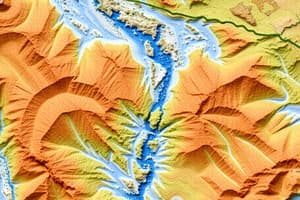Podcast
Questions and Answers
What is the primary focus of physical geography?
What is the primary focus of physical geography?
- The investigation of natural features and processes on the Earth's surface (correct)
- The mapping and exploration of the world's oceans
- The analysis of economic and political systems
- The study of human societies and cultures
Which of the following is a subfield of physical geography?
Which of the following is a subfield of physical geography?
- Political geography
- Geomorphology (correct)
- Human geography
- Economic geography
Which of the following is a specialized discipline within the field of geomorphology?
Which of the following is a specialized discipline within the field of geomorphology?
- Historical geography
- Glacial geomorphology (correct)
- Urban geography
- Cultural geography
What is the primary focus of fluvial geomorphology?
What is the primary focus of fluvial geomorphology?
Which of the following is a key focus of physical geography?
Which of the following is a key focus of physical geography?
What is the relationship between physical geography and the broader field of geography?
What is the relationship between physical geography and the broader field of geography?
Which of the following is a primary focus of climatology?
Which of the following is a primary focus of climatology?
What is a key application of biogeographical research?
What is a key application of biogeographical research?
Which subfield of physical geography focuses on the study of living organisms and their environments?
Which subfield of physical geography focuses on the study of living organisms and their environments?
What is a prominent example of climatological research mentioned in the text?
What is a prominent example of climatological research mentioned in the text?
Which of the following is NOT a component of biogeography?
Which of the following is NOT a component of biogeography?
What is a crucial aspect of understanding geomorphological processes?
What is a crucial aspect of understanding geomorphological processes?
Flashcards are hidden until you start studying
Study Notes
Physical Geography
Introduction
Physical geography, also known as physiography, is a branch of the broader field of geography. It primarily focuses on the natural features and processes of the Earth's surface, particularly in relation to the oceans, lands, atmosphere, and living organisms. This field covers a vast range of topics, including the study of earth's form and structure (geomorphology), weather patterns and climate (climatology), and the distribution of various biological species (biogeography). Here, we will delve deeper into each of these main subfields of physical geography.
Geomorphology
Geomorphology, also known as morphogeography, is a subfield of physical geography dedicated to studying the surface features of the Earth. This includes the natural processes responsible for shaping landforms as well as the historical changes in those features over time. Geomorphology encompasses a variety of specialized disciplines, such as desert geomorphology, fluvial geomorphology, and glacial geomorphology, all of which pertain to specific types of landscapes and processes.
Example:
For instance, desert geomorphology investigates the formation and behavior of sand dunes in arid environments, while fluvial geomorphology explores the development of river channels and floodplains. Both of these sub-fields contribute significantly to understanding the overall geomorphic landscape.
Importance:
Understanding geomorphological processes and their effects are crucial for various applications, including natural hazard assessment, sustainable resource extraction, and ecosystem restoration.
Climatology
Climatology is the branch of physical geography that focuses on studying atmospheric processes and the resulting weather and climate patterns. It combines both short-term meteorological observations and long-term trends to better comprehend the Earth's climate system. Climatological research can span various geographical locations and temporal scales, providing valuable insight into both regional and global climate changes. Climatologists often apply statistical analysis and modeling techniques to decipher complex weather and climate patterns.
Example:
One prominent example of climatological research is the study of monsoonal weather patterns in different parts of the world, such as the North American Monsoon. This understanding helps in predicting seasonal rainfall variability and impacts on agriculture and human populations.
Importance:
The knowledge derived from climatology is vital for informed decision-making regarding environmental conservation, disaster preparedness, and food production.
Biogeography
Biogeography is another major subfield of physical geography, focused on the spatial distribution and interactions of living organisms with their physical environment. It encompasses various components of ecology, such as island biogeography, paleobiogeography, phylogeography, zoogeography, and phytogeography.
Example:
A classic example of biogeographical research is the study of the distribution of certain species across different habitats, which can reveal patterns such as species richness and diversity gradients. This information contributes to the understanding of ecosystem dynamics and conservation strategies.
Importance:
Biogeography provides fundamental insights into the mechanisms driving global biodiversity and helps guide efforts towards preserving Earth's ecological wealth.
In conclusion, physical geography is an intricate field encompassing a multitude of sub-branches and topics. These subfields include geomorphology, climatology, and biogeography, each contributing unique perspectives to our understanding of the natural world. By studying these disciplines, we gain a deeper appreciation for the Earth's complex geological and ecological processes, allowing us to better navigate and protect the planet upon which we depend.
Studying That Suits You
Use AI to generate personalized quizzes and flashcards to suit your learning preferences.




